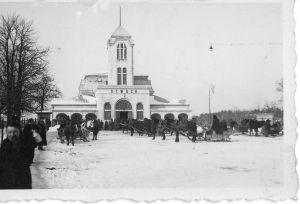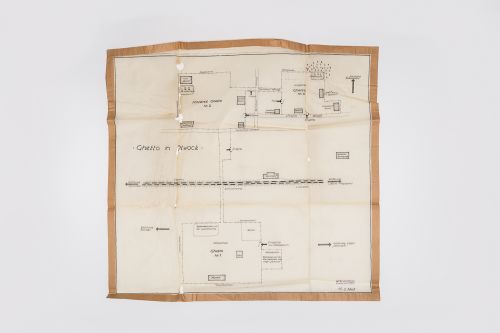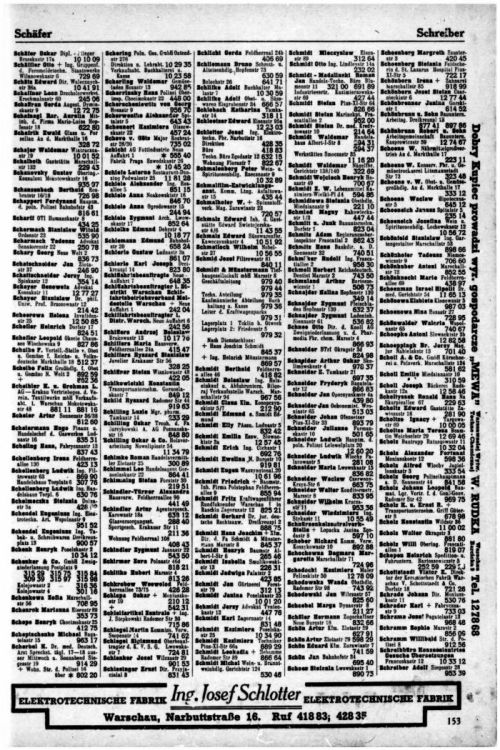Otwock

Otwock Railway Station
In the early 1920’s, about 5,400 Jews lived in Otwock, out of a total population of 8,500. Otwock was a major vacation site in the Warsaw area, and many local Jews earned their living through providing medical services, musical entertainment, waiting tables, supplying kosher food, and other professions related to the tourism and health resort industry. The Otwock Jewish community had a number of charitable societies, and its Bikur Holim society established a clinic for tuberculosis patients and a clinic for the poor. Zionist parties and Agudath Israel were active in Otwock, as was the Bund. The townlet boasted Jewish schools, cultural and sports institutions, as well as youth movements and organisations. During the interwar period, the Jewish inhabitants of Otwock were targeted by a number of anti-Semitic incidents, the most vicious of which were anti-Jewish pogroms that broke out in 1936.
At the outbreak of the Second World War in 1939, many Jewish youths fled the townlet for the east and Otwock was occupied by the Germans on 29 September 1939. At the time, out of a total population of 24,000, there were 13,500 Jews in the townlet, many undergoing cures in the various spas. The Germans immediately set about plundering Jewish property, abducting Jews for forced labour, and murdering Jewish inhabitants. In late 1939, the Jews of Otwock aged twelve and older were ordered to wear a yellow armband. Shop owners were required to display a Star-of David on the front of their stores. In October 1939, a Judenrat headed by Y. Lasman was established in Otwock, its main role was to remit ransom payments to the Germans and provide teams for forced labour. The Jews of Otwock were shipped to labour camps in the Lublin area, and many labourers were sent to Tyszowce. In early July 1940, the first orders were issued regarding the establishment of ghettos in the Warsaw district. With Otwock’s unique status as a health resort and the towns economic life resting on its medical institutions, Otwock’s mayor Jan Gademski, petitioned to postpone the establishment of a ghetto. The request was denied. The orders to establish a ghetto in the town were received on 26 September 1940. The approximately 1,500 Jews who had resided in the town for less than six months, primarily patients treated in sanatoriums were ordered to leave it within two weeks. A number of Jews were concentrated in the Jewish neighbourhood prior to the official moving order, which was issued on 4 November 1940. The establishment of the ghetto was accompanied by the formation of a Jewish Order Service (Ordnungsdienst), headed by Bernard Kronenberg.

Plan of the Otwock Ghetto -March 1947 (Holocaust Montreal Museum)
The ghetto was divided into two parts: a residential area and the sanatorium area. The two quarters were connected by a single street. Only those with a medical permit were allowed to live in the sanatorium area. The ghetto was not completely closed, but the Jews were forbidden to leave their area of residence from seven in the evening to eight o’clock the following morning, and from Friday afternoon until Monday morning. The ghetto was not fenced in until 1941, and Jewish smugglers managed to bring some food into the ghetto by bribing Polish guards. The Germans continued to demand forced labourers. A ‘work’ battalion of some 4,000 people was established, with its members leaving the ghetto daily to perform forced labour in German army camps. To assist the needy, the Judenrat established a number of welfare institutions, including three public soup kitchens, an orphanage with about 200 children, and a children’s home in which some 100 displaced children resided. In addition, the Judenrat instituted a sanitation department to supervise the hospital. The ghetto had another hospital for the mentally ill with about 100 patients. The educational system also continued to function in the ghetto; a number of elementary schools and kindergartens were opened, and Torah classes and lectures on literature and history were offered. Despite the organisation of help for the poor, the social disparities among the ghetto inhabitants continually widened. The wealthy could afford to purchase food and pay to be released from forced labour, whereas some 6,000 of the ghetto’s inhabitants were in need of urgent assistance.During the occupation the German construction firm Schmidt and Munstermann, who built the Warsaw Ghetto wall, as well as the Treblinka Labour Camp and the Treblinka death camp, took over the brickyard at Teklin near Otwock and turned it into a labour camp.

Telephone Directory for Warsaw 1942 - Schmidt und Munstermann Entries (USHMM)
One of those people who used the sanatoriums at Otwock was Adam Czerniakow, the Chairman of the Warsaw Ghetto’s Judenrat: His diary entry for 20 July 1940 reads as follows: I gave myself a 24 hour holiday after all these months – I am leaving for Otwock.... An inspection of the Brijus TB Sanatorium and later of Zofiowka: I notice in Zofowka the woman troublemaker who cost us 100,000 zlotys, adult lunatics and children. One child in a straightjacket to prevent self-injury, the face covered with flies. Another one is scratching wounds on his head. A female singer in bed executes some operatic arias: she used to perform in Italy. Other women by the piano were playing and singing, I joined them. Somebody built himself a tombstone in a cemetery with his name carved on it. It is to this address that he would direct his creditors. In early 1941, conditions in the ghetto worsened considerably, on 10 January 1941 the ghetto was encircled by a fence and anyone who crossed its border was summarily shot. The plunder of Jewish property continued, and in the winter of 1941/42, all furs were confiscated. On 7 July 1941, the sanatorium quarter was reduced in size, and an order was issued restricting the patients and medical staff to three sanatoriums in the quarter. In April 1942 the Germans demanded 400 youths from Otwock to help with the construction of the Treblinka death camp and on 19 August 1942 the Nazis liquidated the Otwock ghetto by sending them to the Treblinka death camp. The day prior to the liquidation, an SS company, Ukrainian –SS under the command of the notorious SS- Obersturmfuhrer Karl Georg Brandt from the SD in Warsaw. Karl Brandt appointed Bernard Kronenberg as head of the Judenrat; Kronenberg’s first job was to dismantle the ghetto’s houses and use the bricks to build a wall around the ghetto. All patients in the ghetto’s hospitals were killed before the general deportation, as were the doctors and nurses in the mental hospital. On the day of their liquidation, some 7,000 Jews were deported to the Treblinka death camp. Their property was plundered by the local Poles. Those Jews who sought refuge in the nearby forests were soon caught and shot. The members of the Jewish Order Service were first sent to Wilanow and then onto Tarchomin camp, where they too were shot and killed.
Sources:
The Yad Vashem Encylopiedia of the Ghettos During the Holocaust Volume 1, Yad Vashem, 2009.
The Warsaw Diary of Adam Czerniakow, Elephant Paperbacks, Chicago 1999
Y. Arad, Belzec, Sobibor, Treblinka – The Aktion Reinhard Death Camps, Indiana University Press, Bloomington and Indianapolis 1987
www.ZydziOtwoccy.pl
Photograph: Tall Trees Archive
Document: USHMM
Map - Holocaust Montreal Museum
© Holocaust Historical Society, March 30, 2021

